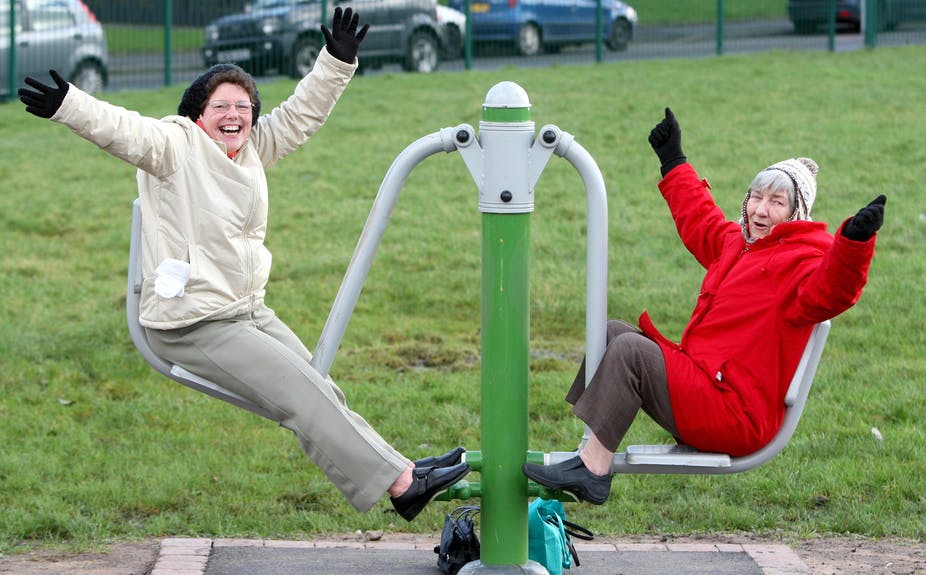When Kathy Thomas’ “big Catholic family” gathers for the holidays, everybody plays bingo. Her 90-year-old mother, Rosemary Doyle (“RoRo” to the grandkids), calls the game, and the winners get fun prizes, like gift cards for Starbucks or Whataburger.
“When we start the bingo, the kids look up from their phones and play; they even post the game on their Instagrams, and their friends all want to join,” said Thomas. “It’s something we can all do together.”
Playing together is a way that Thomas’ family stays connected. When the pandemic hit, the family kept up the tradition via Zoom. It’s just one example of how play can enrich the lives of older adults.
“You’re never too young or too old to play,” said Anna Yudina, marketing director for the Toy Association. “Research links play with a number of wellness benefits in adults, such as reducing stress, boosting life satisfaction and empowering people to be creative, flexible thinkers.”
Play spans a wide gamut, from organized sports and serious hobbies to video games (about 15 percent of gamers in the United States are 55 or older). But all types of play seem to have positive benefits for older adults. Even spontaneous play with grandkids offers benefits—adults who play with children burn 20 percent more calories per week, experience fewer falls, become less reliant on walking aids and are less likely to develop Alzheimer’s in their 70s, according to the Genius of Play initiative, which promotes the value of play for children and adults.
What Is Play? It’s Personal
Stuart Brown, MD, is the founder of the National Institute of Play, a nonprofit that studies the value of play. He resists offering an absolute definition of play because it’s so personal. One person might find hang gliding to be a joyful form of play; another might view it as sheer terror. But Brown does identify the properties of play: it’s done for its own sake; it’s voluntary and fun; it makes us lose track of time and feel less self-conscious. Play also offers opportunities for improvisation and leaves us wanting more.
“Play energizes us,” wrote Brown, author of Play: How It Shapes the Brain and Opens the Imagination and Invigorates the Soul (2009). “The ability to play is critical not only to being happy but also to sustaining social relationships and being a creative, innovative person.”
Brown identifies seven categories of play: body play/movement; object; social; imaginative; storytelling; transformative and creative; and attunement (such as the babbling and eye contact shared between mother and baby).
Body and object primarily involve physical movement, helping to maintain muscle tone and coordination. Social play alleviates isolation and loneliness. The remaining categories engage the brain, helping to preserve cognitive function.
But those distinctions aren’t hard and fast—depending on the specific play, there can be a great deal of overlap between body and mind. Group games can engage the mind while lessening loneliness. Crafts or music (examples of transformative play) involve both mind and body. And all forms of play promote relaxation and reduce stress, especially when laughter and humor are involved.
A Changed Life
Jeannette Jancetich says her favorite form of play—ballroom dancing—changed her life. She choked up a little when recalling the first time she walked into the Fred Astaire Dance Studio in Phoenix, AZ, two years ago.
“Today, I’m in better health, I have better posture, I feel great, I’ve lost weight and I’ve made friends who feel like family,” she said.
A retired banking software executive, Jancetich, 72, said that, due to constant travel, she never had time for dance when she was working. Now, she takes lessons three times a week and competes often. She loves it all: the rehearsals, the costumes and makeup, and the choreographing of dance numbers to fit each competition event’s theme.
Jancetich’s instructor, Sarah Petrov, estimates about 30 percent of her students are older adults. Teaching them reminds her of a job she had in college, working with older adults in a neuropsychology clinic to help improve their brain health.
“Dancers must use both their cognitive and motor skills to follow complicated choreography,” she said. “That’s much like the exercises we used to improve brain health in the clinic.”
Connecting through Play
Play connects people, often in ways that span generations, according to Mary “Molly” Camp, MD, an assistant professor of psychiatry at UT Southwestern Medical Center in Dallas, who specializes in geriatric mental health. She remembers bringing her young son, then 18 months old, to a nursing home to sing and visit with residents. He playfully tossed a ball to an elderly woman in a wheelchair who was nonverbal, due to dementia. Her face lit up and she threw the ball back to the boy.
“They had this immediate connection,” she said. “That tells me that play is hardwired and innate.”
Similarly, Tomislav “Tom” Perić connected with younger people when he rediscovered his favorite form of play—jiujitsu—at age 62. Most of the people he trains with are young enough to be his child or grandchild.
“They consider me the village elder,” he said. “It’s rewarding when younger people at least seem to listen when one offers advice or suggestions.”
Now, at 70, he’s ranked 10th worldwide in his age and skill level categories.
“There’s nothing that I’ve done in the past decade that has been as rewarding, physically and psychically, as martial arts,” he said. “It’s the only activity that makes me feel like I’m 35 again.”
At the end of each class, Perić said, “all cylinders are firing. I feel satisfied that I have learned something new. Physically, I feel more limber. I feel a sense of camaraderie with my teammates. And for a moment, I feel like anything is possible.”
Mastering skills like ballroom dance or martial arts involves practice and repetitive drills that require concentration and persistence. Do these pursuits still qualify as play?
Yes, according to Camp.
“People can approach play with a very serious mindset,” she said. “That sense of being fully immersed in the activity and ‘in the moment’ is what adds to their enjoyment.”
Less serious, lighthearted play—card and board games, crafts, singalongs, puzzles and more—is also beneficial. Activities directors in senior living communities constantly try to devise new ways to get residents to play, to help them stay active and engaged and to meet other people. Play can serve as a distraction that helps ward off bouts of agitation and depression, common issues for those with Alzheimer’s or dementia. And while games like balloon badminton may seem simplistic, they lure residents to common areas for laughter and team play, which helps people feel like contributing members of their community.
Play can even heal relationships. Camp has heard from older adult patients who reported that some forms of play—like golfing or playing cards—helped mend or maintain longtime friendships that fractured in recent years over bitter political differences. Play provided a shared interest, Camp said, “that allowed them to keep connecting with each other without stepping on those land mines.”
A Childlike Spirit
As the creator of popular board games like Taboo, Outburst, Super Scattergories and Boom Again, Brian Hersch has carefully analyzed what makes an activity fun.
At its best, he said, play reconnects us with childhood memories as well as with a childlike spirit.
“Play allows us to disengage from the obligatory and takes us back to our childhoods,” he said. “It reminds us of those innocent times of just having fun, before life became crowded with obligations.”
Hersch has two rules of thumb for every game he’s created: it must generate laughter and “head slaps.” When people laugh, they’ll play the game again and tell their friends about it. And head slaps happen when players truly connect to the game.
“If it’s a trivia game, for example, and the questions lead players to say, ‘Oh, no one knows that,’ then it’s no longer fun,” he said. “But if they slap their heads and say, ‘Of course!’ when they hear an answer, then you know it’s working. Even if they couldn’t come up with the answers, they were connected to the game.”
All Work, No Play
Many researchers believe American adults of all ages don’t spend enough time playing. Some may feel compelled to fill each day with productive activity; others may assume play is too silly for grownups. One study found that 84 percent of adult respondents said that taking time to play helps them be more productive at work.
“Play is just as important for our overall health and wellness as sleep, nutrition and exercise,” said Tom Norquist, past president of the International Play Equipment Manufacturers Association. “It keeps us feeling young and energetic.”
Norquist says that his career taught him to maintain a playful attitude in life. “I take pride in enjoying all those little moments—swinging on a tire swing with my granddaughters, hiking with my wife, doing cannonballs into our pool every summer—because I don’t take life too seriously. Play is a way of life.”

Freelance writer Mary Jacobs lives in Plano, TX, and covers health and fitness, spirituality, and issues relating to older adults. She writes for the Dallas Morning News, the Senior Voice, Religion News Service and other publications; her work has been honored by the Religion Communicators Council, the Associated Church Press and the American Association of Orthopaedic Surgeons. Visit www.MaryJacobs.com for more.



